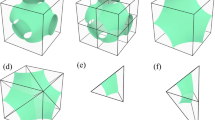Abstract
In this paper, a new parameterization of the mechanical properties is proposed for the optimal selection of materials. Recent parameterization schemes from multi-phase topology optimization (i.e. Discrete Material Optimization—DMO) are compared to this novel approach in the selection of conventional laminates including only 0°, − 45°, 45° and 90° plies. In the new parameterization the material stiffness is computed as a weighted sum of the candidate material properties, and the weights are based on the shape functions of a quadrangular first order finite element. Each vertex of the reference quadrangle then represents a candidate ply. Compared to DMO, this method requires fewer design variables, since the four pseudo-densities representing the presence or the absence of a given candidate ply in DMO are now replaced, in the weights, by two design variables, which are the two natural coordinates of the reference quadrangular element sufficient to identify each of the four vertices. Another advantage of the new parameterization scheme is to penalize, in a more convenient way, the intermediate values of the design variables, possibly avoiding any blending of materials at the solution. Three simple numerical applications with in-plane loadings are proposed and solved in order to demonstrate that the new approach is an interesting alternative to DMO, able to select the optimal orientations and to combine the material distribution with optimal orientation problems.














Similar content being viewed by others
References
Bendsoe MP, Sigmund O (2004) Topology optimization: theory, methods and applications. Springer-Verlag
Bruyneel M (2006) A general and effective approach for the optimal design of fiber reinforced composite structures. Compos Sci Technol 66:1303–1314
Bruyneel M, Grihon S, Sosonkina M (2010) New approach for the stacking sequence optimization based on continuous topology optimization. In: 8th ASMO UK/ISSMO conference on engineering optimization, London, 8–9 July
Diaconu C, Sekine H (2004) Layup optimization for buckling of laminated composite shells with restricted layer angles. AIAA J 42(10):2153–2163
Fu JF, Fenton RG, Cleghorn WL (1991) A mixed integer-discrete-continuous programming method and its application to engineering design optimization. Eng Optim 17:263–280
Haftka RT (1992) Stacking sequence optimization for buckling of laminated plates by integer programming. AIAA J 30(3):814–819
Hammer V (1997) Design of composite laminates with optimized stiffness, strength and damage properties. PhD thesis, DCAMM Report S72, Technical University of Denmark
Kin CC, Lee YJ (2004) Stacking sequence optimization of laminated composite structures using h-genetic algorithm with local improvement. Compos Struct 63(3):339–345
Le Riche R, Haftka RT (1993) Optimization of laminate stacking sequence for buckling load maximization by genetic algorithm. AIAA J 31(5):951–956
Liu D, Toropov V, Barton D, Querin O (2009) Two methodologies for stacking sequence optimization of laminated composite materials. In: Proceedings of the international symposium on computational structural engineering, Shangai, China, 22–24 June
Lund E (2009) Buckling topology optimization of laminated multi-material composite shell structures. Compos Struct 91:158–167
Lund E, Stegmann J (2004a) Structural optimization of composite shell structures using a discrete constitutive parameterization. XXI ICTAM, Warsaw, Poland, 15–21 August
Lund E, Stegmann J (2004b) On structural optimization of composite shell structures using a discrete constitutive parameterization. Wind Energy 8:109–124
Lund E, Kühlmeier L, Stegmann J (2005) Buckling optimization of laminated hybrid composite shell structures using discrete material optimization. In: 6th World congress on structural and multidisciplinary optimization, Rio de Janeiro, Brazil, 30 May–3 June
Pedersen P (1989) On optimal orientation of orthotropic materials. Struct Optim 1:101–106
Pedersen P (1991) On thickness and orientational design with orthotropic materials. Struct Optim 3:69–78
Radovcic Y, Remouchamps A (2002) BOSS Quattro: an open system for parametric design. Struct Multidiscipl Optim 23:140–152
SAMCEF Système d’Analyse des Milieux Continus par Eléments Finis. http://www.samtech.com
Sigmund O, Torquato S (2000) Design of materials with extreme thermal expansion using a three-phase topology optimization method. J Mech Phys Solids 48:461–498
Stegmann J (2005) Analysis and optimization of laminated composite shell structures. PhD thesis, Aalborg University, Denmark
Stegmann J, Lund E (2005) Discrete material optimization of general composite shell structure. Int J Numer Methods Eng 62:2009–2027
Stolpe M, Svanberg K (2001) On the trajectory of penalization methods for topology optimization. Struct Multidiscipl Optim 21:128–139
Svanberg K (1987) The method of moving asymptotes: a new method for structural optimization. Int J Numer Methods Eng 24:359–373
Zienkiewicz OC (1977) The finite element method, 3rd edn. McGraw-Hill, New York
Acknowledgements
The author would like to thank the Walloon Region of Belgium and Skywin (Aerospace Cluster of Wallonia) for their financial support through the project VIRTUALCOMP.
Author information
Authors and Affiliations
Corresponding author
Rights and permissions
About this article
Cite this article
Bruyneel, M. SFP—a new parameterization based on shape functions for optimal material selection: application to conventional composite plies. Struct Multidisc Optim 43, 17–27 (2011). https://doi.org/10.1007/s00158-010-0548-0
Received:
Revised:
Accepted:
Published:
Issue Date:
DOI: https://doi.org/10.1007/s00158-010-0548-0




